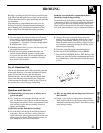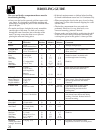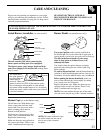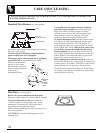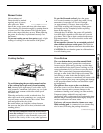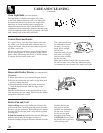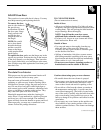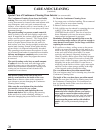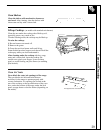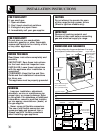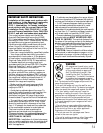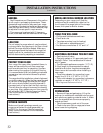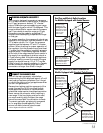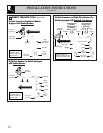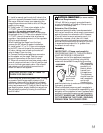
28
CARE AND CLEANING
(continued)
Special Care of Continuous-Cleaning Oven Interior (on some models)
The Continuous-Cleaning Oven cleans itself while
cooking. The oven walls are finished with a
special
coating that cannot be cleaned in the usual manner with
soap, detergents, steel wool pads, commercial oven
cleaners, coarse abrasive pads or coarse brushes. Use of
such cleansers and/or the use of oven sprays will cause
permanent damage.
The special coating is a porous ceramic material,
which is dark in color and feels slightly rough to the
touch. If magnified, the surface would appear as peaks,
valleys and sub-surface ‘‘tunnels.’’ This rough finish
tends to prevent grease spatters from forming little
beads or droplets that run down the side walls of a
hard-surface oven liner, leaving unsightly streaks that
require hand cleaning. Instead, when spatter hits the
porous finish, it is dispersed and partially absorbed.
This spreading action increases the exposure of oven
soil to heated air and makes it somewhat less noticeable.
Soil may not disappear completely and at some time
after extended usage, stains may appear that cannot
be removed.
The special coating works best on small amounts
of spatter. It does not work well with larger spills,
especially sugars, egg or dairy mixtures. The oven
bottom does not have the continuous cleaning oven
coating and can be removed and cleaned with a
commercial oven cleaner.
This special coating is not used on the oven
shelves, oven bottom or the inside of the oven
door. Remove these to clean with a commercial
oven cleaner to prevent damaging the Continuous-
Cleaning Oven coating.
Make sure the oven bottom is in place before
you turn the oven on for any reason.
Use care in removing and replacing the oven
bottom and shelves and in placing and removing
dishes and food to avoid scratching, rubbing or
otherwise damaging the porous finish on the oven walls.
To Clean the Continuous-Cleaning Oven:
1. Let range parts cool before handling. We recommend
rubber gloves be worn when cleaning.
2. Remove shelves and cookware.
3. Soil visibility may be reduced by operating the oven
at 400°F. Close the door and turn the OVEN
CONTROL knob to 400°F. Time for at least four
hours. Repeated cycles may be necessary before
improvement in appearance is apparent.
Remember: During the operation of the oven, the
door and other range surfaces will get hot enough to
cause burns. Do not touch. Let the range cool before
replacing the oven shelves.
4. If a spillover or heavy soiling occurs on the porous
surface, as soon as the oven has cooled, remove as
much of the soil as possible using a small amount of
water and a stiff-bristle nylon brush. Use water
sparingly and change it frequently, keeping it as
clean as possible, and be sure to blot it up with paper
towels, cloths or sponges. Do not rub or scrub with
paper towels, cloths or sponges, since they will leave
unsightly lint on the oven finish. If water leaves a
white ring on the finish as it dries, apply water again
and blot it with a clean sponge, starting at the edge
of the ring and working toward the center.
The oven bottom has a porcelain enamel finish.
The oven bottom comes out for cleaning away from the
Continuous-Cleaning Oven.
The inside of the oven door has a porcelain enamel
finish. The oven door lifts off for cleaning away from
the Continuous-Cleaning Oven. For instructions on
how to clean the inside of the oven door refer to the
Lift-Off Oven Door section.
Do not use soap, detergent, steel wool pads,
commercial oven cleaner, silicone oven sprays,
coarse pads or coarse brushes on the porous
surface. These products will spot, clog and damage
the porous surface and reduce its ability to work.
Do not scrape the porous surface with a knife or
spatula—
they could permanently damage the
finish.




